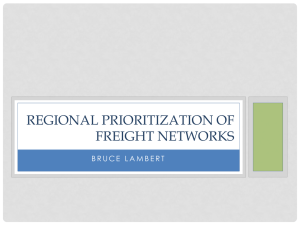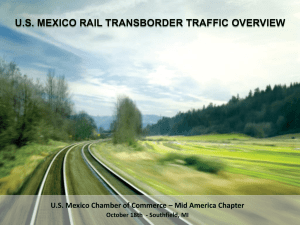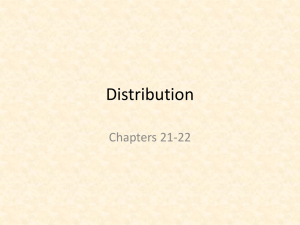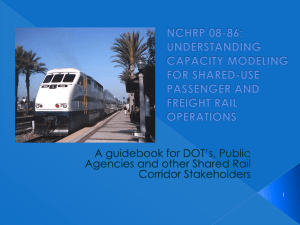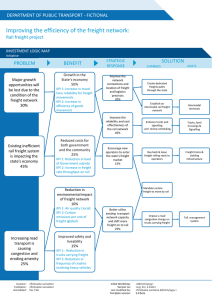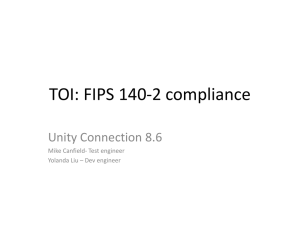Disaggregate State Level Freight Data to County Level
advertisement
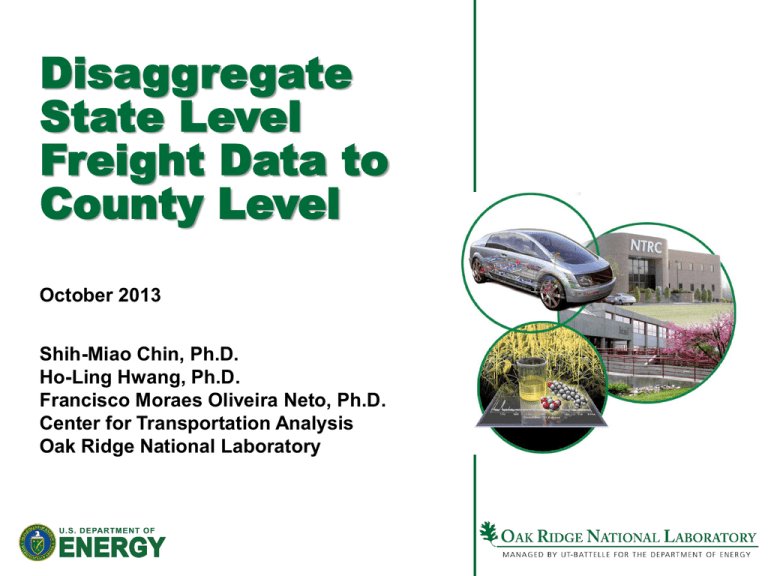
Disaggregate State Level Freight Data to County Level October 2013 Shih-Miao Chin, Ph.D. Ho-Ling Hwang, Ph.D. Francisco Moraes Oliveira Neto, Ph.D. Center for Transportation Analysis Oak Ridge National Laboratory Outline Background Freight Analysis Framework (FAF) Major data sources Methodology Disaggregation process Example Results & Validations FAF Ton-miles Comparison with other freight data programs Remarks Background: Freight Analysis Framework (FAF) Manages by the Office of Freight Management and Operations, Federal Highway Administration (FHWA) Provides a comprehensive picture of freight movement among states and major metropolitan areas by all modes Most current release is FAF3.4 database Geography 123 domestic regions 8 foreign regions Canada Modes of transportation Eastern Asia SW & Central Asia Europe Africa South, Central Eastern Asia & Western Asia SE Asia & Oceania Mexico Mexico Rest of Americas Truck Rail Water Air/air-truck Multiple mode/mail Pipeline Others/unknown 43 Commodities Background: Major Data Sources Commodity Flow Survey (CFS) Conducted under the partnership of U.S. Census and Bureau of Transportation Statistics (BTS) Sample survey of business U.S. establishments & classified according to North American Industry Classification System (NAICS) codes Latest available data: 2007 (i.e., base year data for FAF3) County Business Patterns (CBP) An annual data series from U.S. Census Provides economic data by industry (# establishments, employment, payroll) Latest available data: 2011 Industry Input-Output (I-O) Accounts Annual I-O tables produced by the Bureau of Economic Analysis (BEA) Make and Use Tables, by industry according to NAICS codes Latest available data: 2011 FAF3 Disaggregation: Estimation of Ton-Miles Tonnage and value of goods moved are important measures of the freight activity, but they do not necessarily reflect the usage of transportation systems Environmental impact (emissions and fuel efficiency) of freight activity can be assessed using measures normalized by ton-miles The revenue of transportation firms is related to the amount of freight in tones transported per mile Main disaggregation steps Linking freight activities with economic activities Disaggregate FAF3 database (ODCM tonnage matrix) to county level Estimate average shipment distance by mode on the multimodal network systems Freight Flow Disaggregation Approach o Production f FAF zone-to-zone, Commodity, Mode j i d Attraction CBP BEA I-O Accounts (apq) CBP ωOrigin county / Commodity, Mode ωDestination county / Commodity, Mode Information theory ωcounty-to-county by commodity & mode ωO/ C, M = ∑ωO / I ωI / C, M ωD/ C, M = ∑ωD / I ωI / Where (o, d) – FAF OD pair & (i, j) – County pair C, M Methodologies/Models Log-linear regression models for linking freight activity with economic activity by industry sector at state Production: freight tonnage shipped & payroll of producing industry Attraction: freight tonnage received & payroll of receiving industry Total tons shipped by state (thousands) 9 x 10 4 Production curve for food manufacturing 8 y = 6.52x1.09 R2 = 0.85 7 6 5 4 3 2 1 0 0 1000 2000 3000 4000 5000 6000 7000 Payroll of food manufacturing by state (millinos of dollars) Estimates of county-level production/attraction shares by industry Spatial distribution by matrix balancing procedures (or doubly constraint gravity model) Distance Matrices Intermodal Network Highway Network #2 Movement destination Terminal Access/Egress Links Rail Network Terminal links Highway: Contains 500,000 miles of roadway in the US, Canada, and Mexico Railway: Contains every railroad route in the US, Canada, and Mexico that has been active since 1993 Waterway: Contains inland and off-shore links Origin of movement Highway access link Highway Network #1 http://cta.ornl.gov/transnet/ Baltimore Example: Destination County FIPS 241 Origin County 24003 24005 24013 24025 24027 24035 24510 FIPS 242 D= 24009 49 76 96 93 67 73 69 24017 51 74 94 91 62 79 67 24021 70 62 29 88 47 100 58 24031 44 50 42 76 23 71 44 24033 27 50 68 67 31 54 43 24037 71 99 118 116 86 95 91 Estimated using the highway network system in GIS 9 Managed by UT-Battelle for the U.S. Department of Energy FAF zone to county disaggregation – generation and attraction by county NAICS 311 FIPS Total 24009 0 24017 145 24021 20,300 24031 11,798 24033 29,754 24037 292 FAF O-D Flow (short tons) t242,241,truck = 171,747 Production Model (Production Share) Attraction Model (Attraction Share) Annual payroll ($ 1000) in the origin counties yˆ rm ,311,truck 10 Managed by UT-Battelle for the U.S. Department of Energy NAICS 311 FIPS Total 24003 144,451 24005 292,850 24013 40,136 24025 52,675 24027 88,878 24035 10,939 24510 393,440 Share of annual payroll ($ 1000) in the destination counties PRODUCTIONS FIPS Tons 24009 0 24017 222 24021 55,562 24031 30,297 24033 85,180 24037 486 Total 171,747 ATTRACTIONS FIPS Tons 24003 22,614 24005 51,059 24013 5,169 24025 7,071 24027 12,922 24035 1,156 24510 71,755 Total 171,747 yˆ rm ,311,truck FAF to county disaggregation – distribution and spatial interaction yˆ rm ,311,truck NAICS 311 yˆ rm ,311,truck 11 24003 24005 24013 24025 24027 24035 24510 FIPS 22,614 51,059 5,169 7,071 12,922 1,156 71,755 Tons FIPS Tons 24009 0 0 0 0 0 0 0 0 24017 222 32 65 6 9 16 2 93 24021 55,562 6,548 16,893 2,073 2,263 4,144 330 23,312 24031 30,297 3,868 8,997 928 1,205 2,404 199 12,697 24033 85,180 12,096 24,963 2,150 3,574 6,324 622 35,451 24037 486 12 20 34 Managed by UT-Battelle for the U.S. Department of Energy 71 142 4 202 yˆ rsm ,311 f ( yˆ r ,311,truck , yˆ s,311,truck , d rs ,truck ) Matrix of Total Tons by Truck Destination County FIPS Origin County FIPS 24003 24005 24013 24025 24027 24035 24009 32,842 33,744 3,978 7,524 16,094 2,232 26,197 122,611 24017 75,066 90,196 8,747 18,270 37,555 4,554 65,519 299,907 24021 202,845 445,228 102,333 69,463 180,529 10,952 302,784 1,314,134 24031 385,372 613,635 102,795 106,944 342,452 22,376 482,374 2,055,948 24033 363,469 436,776 45,599 87,047 206,271 19,945 361,597 1,520,703 24037 62,792 78,809 6,429 13,991 28,173 3,922 1,122,386 1,698,387 269,881 303,239 811,074 Total Tons Matrix of Tons * Distance Matrix 12 Managed by UT-Battelle for the U.S. Department of Energy 24510 Total Tons 57,583 251,699 63,981 1,296,054 5,565,002 Matrix of Ton-miles FAF Ton-miles Estimates Share of Ton-miles by Mode 6% 10% 1% 0% 44% 0% 14% 25% Average Shipment Distance 239 185 Other and unknown Truck 534 Pipeline 600 Air (include truck-air) 636 Water 705 Rail Multiple modes & mail 800 Value/ Ton-miles ($) Truck 4.67 Rail 0.40 Pipeline 0.91 Multiple modes & mail 3.67 Water 0.48 Other and unknown 4.94 Air (include truck-air) 140.90 Include all domestic, exported, and imported shipments transported within the U.S. Comparisons with Other Freight Data Programs U.S. Network Data source / Modes Sub-system Highway FAF3 (Truck single mode only) 2007 CFS (Truck single mode only) FAF3 (Rail single mode plus rail portion of Railway multiple modes) 2007 CFS (Rail single mode and portion of multiple modes which includes rail) 2007 AAR report (all rail activities) FAF3 (water and the water portion of Waterway multiple modes) 2007 CFS (water and the portion of multiple modes which includes water) 2007 USACE waterborne commerce (all water activities) Ton-miles (billions) 2,473 1,342 1,726 1,530 1,820 554 348 506 Concluding Remarks To carry out national transportation freight analysis and planning at a level of detail The disaggregation methodology will provide more data at a more geographic detailed level for: Environmental impact assessment Vulnerability and resilience of freight multimodal network Modal shift analysis Truck weight and size studies Further work is required to estimate freight flow models through FAF regions, by commodity, by mode.
